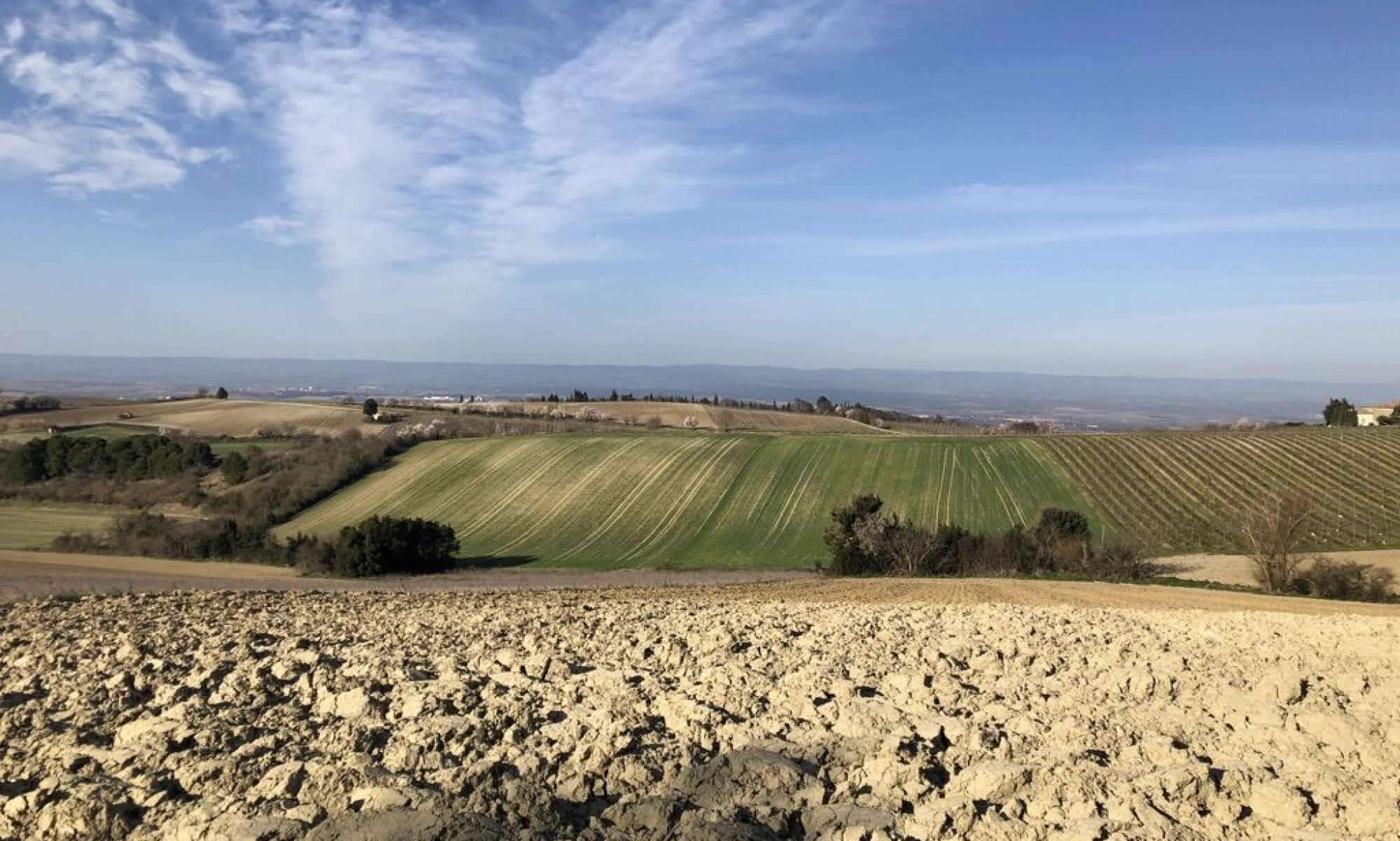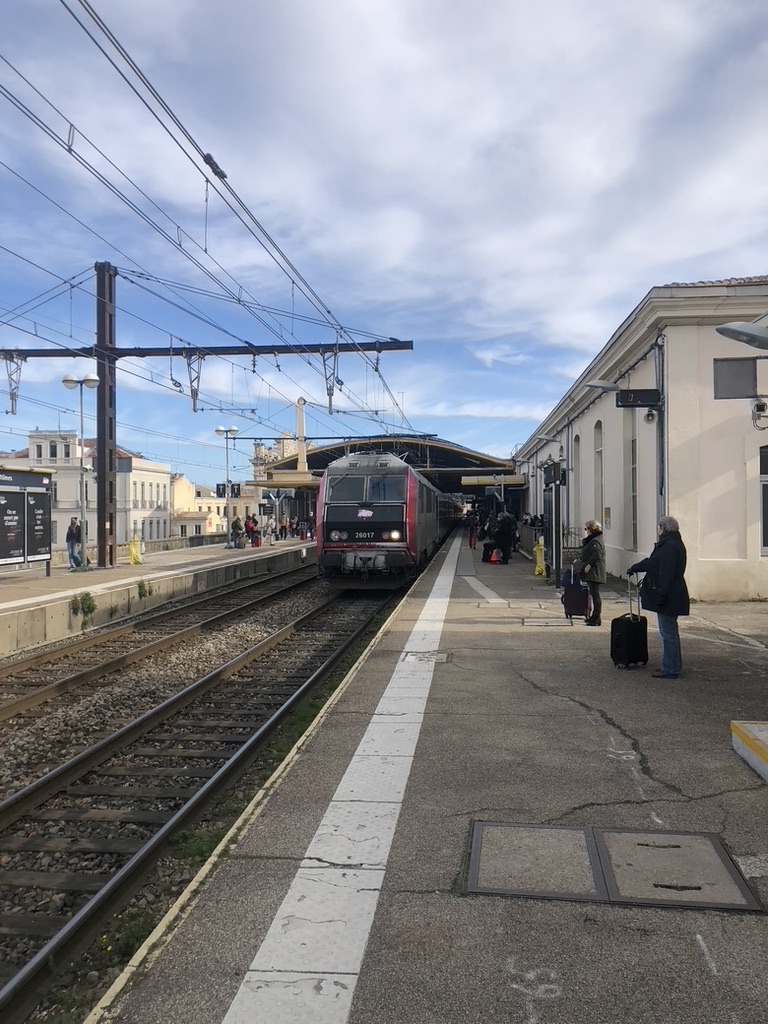As I recently posted, we are enjoying a two-week hiatus from classes. The French do it right. These regularly scheduled vacations are organized by region so that the entire student population isn’t on vacation all at the same time. These past two weeks have been assigned to Occitanie, a region mostly in the south central part of the country.
Officially it is called Vacances d’hiver or Winter Vacation and began February 19. It ends March 7. Families often use this for a ski holiday and fortunately this year there is lots of snow in the Alps as well as the Pyrénées, most of the latter being in our region.
Given that skiing is a part of my past history but still feeling the need to do something, I decided that I would take short trips to places I hadn’t yet been but have longed to see.
First, was a visit to Nîmes.
Nîmes has been described as “the most Roman city outside of Italy” and for good reason with its Roman ruins. Because of this it is also sometimes called the French Rome.
Being two hours away (and with the pandemic lockdowns), it hasn’t been possible up to now to make the trip to Nîmes. But having a clear calendar for these two weeks, it was a great first choice as our freedom to move about in France returns.

I booked a train out of Carcassonne to make the trip less stressful and more enjoyable. Trains in France are relatively inexpensive and even first-class is often only a few euros more for increased comfort and a reserved seat. Parking at the Carcassonne Gare is also easy and possible to book online. I can drive there in about 20 minutes, park my car, and walk onto the train.
The train departed at 9:30 AM last Thursday morning and by 11:20 AM I was in Nîmes.

Walking out of the train station I was impressed to see a long pedestrian boulevard called the Esplanade Charles de Gaulle with beautifully tended trees and plantings extending towards the Pradier Fountain dating from 1845. The esplanade is evidently quite new and I commend the city for its planning and maintenance. So many French towns appear dirty and shabby, but not this one. They have obviously taken great care to make the city welcoming and attractive. In fact, on the way back to the train station to return home the next day, I saw a man driving a van marked with the name and seal of the city so I stopped him and told him how beautiful, clean and attractive I found the city. It was not a lie. “C’est impressionant.” (It’s impressive.”) He was pleased and I was happy to be able to share my appreciation because it really does stand out.


Reaching the fountain, a glance to the left revealed the Roman arena which dates back to 70 AD built during the reign of the Emperor Augustus. It was thrilling to see. Over the centuries it has been used for a variety of purposes, including housing. Napoleon took it back, however, and had it restored to its original glory. Today it is used for concerts and even bullfights. It’s not as large as the Coliseum in Rome, but it is big enough and is reportedly the best preserved in the world seating 24,000.








After spending about an hour walking around the interior of the arena with an audio guide, I moved on to the Musée de la Romanité right across the street. The museum is a stark contrast architecturally as it is of ultra-modern design. Designed by Brazilian architect Elizabeth de Portzamparc, it is a beautiful building telling the story of Nîmes from the Gallic (pre-Roman) times through the medieval ages and well worth the visit. A complete tour with audio guide costs 12 euros and takes about 90 minutes.










I finally stopped for lunch following my tour of the museum then headed up Boulevard Victor Hugo to the Maison Carrée, one of the best preserved Roman temples in the world dating from the first century AD. Its design inspired the Église Madeleine in Paris as well as the Virginia State Capitol, thanks to Thomas Jefferson who visited the city as Ambassador to France in 1787.



Leaving the Maison Carrée, I headed back to the hotel walking through the medieval quarter, charming and also beautifully maintained with inviting narrow streets waiting to be explored.


Aside from its Roman ruins, Nîmes is also famous as the home of denim (“de Nîmes”) dating back 300 years though there is some academic debate as there were variations from Genoa, Italy and England.
If you are up for a visit to Nîmes, it might be fun to plan a visit during La Semaine Romaine where there are re-enactments of gladiator games, etc. This year’s festivities are slated for May 2-8. And, should you have a car and the time, visit the Pont du Gard, the ancient aqueduct that provided water for Nîmes.
As I was only gone overnight, I left out extra food and a dish of ice that would melt to water for the cat. Despite the short time away (less than 30 hours), my cat let me know with her crying that I was missed. I felt guilty. And this influenced my decision for what I was going to do this week.
I was a bit up in the air regarding my next excursion, but gave some thought to a visit to Spain. While I have been to Barcelona more than a few times, I haven’t been to Spain at all since I arrived here to live here three years ago. I have also wanted to see the Costa Brava and Girona, a medium-sized city halfway to Barcelona. Lloret de Mar is a rather popular beach resort about 30 km from Girona. So I thought a fun second trip would be to visit both with an overnight at the beach. There is an outlet center not far from the French frontier called Gran Jonquera, so I thought adding a stop there would be interesting to see what they have on the way home. Rumor has it that liquor is substantially cheaper in Spain. And I’ve had a very difficult time finding my favorite scotch in France: Dewar’s White Label – that is, until last week.
I was shopping at the InterMarché in Carcassonne for the first time last week and finally found a bottle of Dewar’s. However, its price is extraordinary. I can get a bottle on my return trips from the US at the duty-free shop for around US$20. Here it was 30 euros. Online there are bargains out of Spain, but adding the shipping costs makes it more expensive.
Long story short, I was having tea with Chantal last weekend and proposed we drive to Spain to see if I could find my scotch and have lunch somewhere en route or…. But there would be no overnight trip. Barcelona, Girona and Lloret de Mar will have to wait. She was interested so we set out yesterday.
Our first stop was Port-Vendres on the Mediterranean, not far from the Spanish frontier. Historically, Port-Vendres was important even to the Romans due to its deep harbor. During WW II, it was similarly an important base for the Nazis. Today, it serves cruise ships and freighters.




It was a pleasant enough day though overcast. Regardless, we made our way and found a restaurant on the harbor where we sat outside to enjoy the sun peaking in and out of the clouds.
Les Moules Marinière (mussels) were delicious. For dessert we both had a Tarte aux Pommes which I found a bit bland.
From Pont-Vendres, we traveled another 30 minutes on back roads to Le Perthus at the French/Spanish border. Le Perthus is in fact the border: one side of the street is France and the other, Spain.

On the Spanish side are countless stores selling food, alcohol, cigarettes, leather goods, cosmetics, etc, all at discounted prices.
We went into the largest supermarket which had a huge assortment of liquor, but no Dewar’s. Chantal made her way to the tabac and found cigarettes discounted by about 60%. In the end, I found a new wallet which I was needing, so the visit wasn’t in vain for either of us.
The Spanish frontier is only 90 minutes from home via the motor route, so it was a quick drive back. En route, I noted a monument but had no idea what it was until I read an article in today’s New York Times. There is always something to discover.

Les Vacances d’hiver will soon be over and on Monday it will be back to the books. It’s been a nice break from the three classes I have giving me time to relax and read some pretty wonderful books. But that is another story.


Well done, Tom. Thank you!!
It is obvious that you spend considerable time putting these together. Your time and effort are appreciated!!
So enjoyable!
Thanks,Tom. As I write I often will research to provide more background. Hence, being the perennial student, I add the annotations so that those interested can dig deeper. I find too that I learn more, an example here being the names of the esplanade in Nîmes and the church in Pont-Vendres. It is part of the fun.
Fun and educational.
Fascinating “tour” for those who cannot be there in person. Thanks
I see you used Kristin’s camera to great effect, Tom 🙂
Thank you for all the photos. Now I want more than ever to see Nimes.
As always, Tom, your tours make me feel I came along with you! Thanks again!